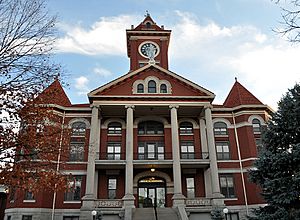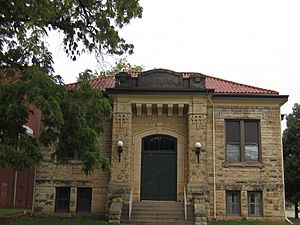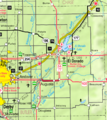El Dorado, Kansas facts for kids
Quick facts for kids
El Dorado, Kansas
|
|
|---|---|
|
City and County seat
|
|
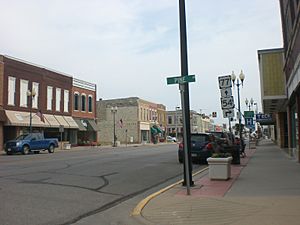
Main & Pine in El Dorado (2012)
|
|
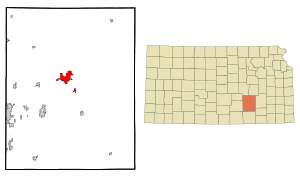
Location within Butler County and Kansas
|
|
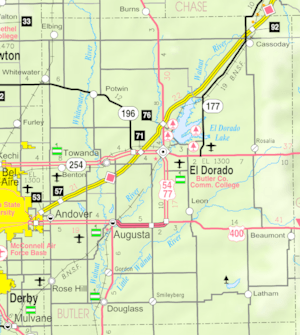
|
|
| Country | United States |
| State | Kansas |
| County | Butler |
| Founded | 1860s |
| Platted | 1868 |
| Incorporated | 1871 |
| Government | |
| • Type | Commission-Manager |
| Area | |
| • Total | 9.20 sq mi (23.82 km2) |
| • Land | 9.16 sq mi (23.72 km2) |
| • Water | 0.04 sq mi (0.09 km2) 0.67% |
| Elevation | 1,332 ft (406 m) |
| Population
(2020)
|
|
| • Total | 12,870 |
| • Density | 1,398.9/sq mi (540.3/km2) |
| Time zone | UTC-6 (CST) |
| • Summer (DST) | UTC-5 (CDT) |
| ZIP code |
67042
|
| Area code | 316 |
| FIPS code | 20-20075 |
| GNIS ID | 485567 |
El Dorado (pronounced EL-də-RAY-doh) is a city in Butler County, Kansas, United States. It is also the county seat, which means it's the main town where the county government is located. El Dorado is found along the Walnut River in south-central Kansas.
In 2020, about 12,870 people lived in El Dorado. The city is also home to Butler Community College, a well-known school.
Contents
History of El Dorado
El Dorado was first planned and mapped out in 1868. Its name comes from Spanish and means "golden land." The city officially became a town in 1870.
Railroad Connections
In 1877, a train line was built from Florence to El Dorado. This line later grew to connect other towns like Augusta and Arkansas City. The Atchison, Topeka and Santa Fe Railway operated these trains. The part of the line from Florence to El Dorado was eventually closed in 1942.
Oil Discovery
A very important event happened in 1915: the El Dorado Oil Field was discovered. This was special because it was one of the first oil fields found using scientific mapping. By 1918, it was the biggest oil producer in the United States, making about 12.8% of all the oil in the country and 9% of the world's oil! Some people even said it was "the oil field that won World War I" because it provided so much fuel for the war effort.
World War II and Tornado
During World War II in 1943, German and Italian prisoners of war were brought to Kansas. This helped with a shortage of workers because many American men were away fighting. These prisoners often volunteered to work on local farms, which allowed them to spend time outside and get better food.
Later, on June 10, 1958, a powerful tornado hit El Dorado. Sadly, 13 people lost their lives. In 2008, the city built a memorial at Graham Park to remember those who died.
Geography and Climate
El Dorado is located on the western side of the Walnut River, not far from El Dorado Lake. It's about 30 miles (48 km) east-northeast of Wichita. Major roads like U.S. Routes 54 and 77 meet here. The Kansas Turnpike (which is also Interstate 35) goes around the northwest side of the city.
The city covers about 8.92 square miles (23.10 km2), with most of that being land and a small part being water.
El Dorado's Weather
El Dorado has a humid subtropical climate. This means it has hot, humid summers and winters that are usually mild to cool.
| Climate data for El Dorado, Kansas, 1991–2020 normals, extremes 1893–present | |||||||||||||
|---|---|---|---|---|---|---|---|---|---|---|---|---|---|
| Month | Jan | Feb | Mar | Apr | May | Jun | Jul | Aug | Sep | Oct | Nov | Dec | Year |
| Record high °F (°C) | 78 (26) |
84 (29) |
94 (34) |
99 (37) |
101 (38) |
108 (42) |
117 (47) |
116 (47) |
112 (44) |
98 (37) |
85 (29) |
80 (27) |
117 (47) |
| Mean maximum °F (°C) | 66.0 (18.9) |
71.3 (21.8) |
79.8 (26.6) |
85.9 (29.9) |
89.9 (32.2) |
95.4 (35.2) |
100.1 (37.8) |
99.6 (37.6) |
95.1 (35.1) |
87.0 (30.6) |
75.6 (24.2) |
66.5 (19.2) |
101.6 (38.7) |
| Mean daily maximum °F (°C) | 44.1 (6.7) |
48.9 (9.4) |
58.9 (14.9) |
68.4 (20.2) |
76.9 (24.9) |
86.3 (30.2) |
91.3 (32.9) |
90.3 (32.4) |
82.7 (28.2) |
71.1 (21.7) |
57.8 (14.3) |
46.4 (8.0) |
68.6 (20.3) |
| Daily mean °F (°C) | 32.1 (0.1) |
36.1 (2.3) |
45.8 (7.7) |
55.7 (13.2) |
65.7 (18.7) |
75.2 (24.0) |
80.0 (26.7) |
78.5 (25.8) |
70.5 (21.4) |
58.1 (14.5) |
45.5 (7.5) |
35.1 (1.7) |
56.5 (13.6) |
| Mean daily minimum °F (°C) | 20.2 (−6.6) |
23.4 (−4.8) |
32.8 (0.4) |
43.1 (6.2) |
54.5 (12.5) |
64.2 (17.9) |
68.8 (20.4) |
66.8 (19.3) |
58.2 (14.6) |
45.2 (7.3) |
33.1 (0.6) |
23.7 (−4.6) |
44.5 (6.9) |
| Mean minimum °F (°C) | 3.3 (−15.9) |
6.9 (−13.9) |
15.4 (−9.2) |
28.1 (−2.2) |
40.0 (4.4) |
53.9 (12.2) |
59.9 (15.5) |
57.6 (14.2) |
42.9 (6.1) |
29.1 (−1.6) |
16.9 (−8.4) |
8.1 (−13.3) |
−0.1 (−17.8) |
| Record low °F (°C) | −23 (−31) |
−28 (−33) |
−10 (−23) |
12 (−11) |
25 (−4) |
43 (6) |
44 (7) |
42 (6) |
28 (−2) |
12 (−11) |
−4 (−20) |
−18 (−28) |
−28 (−33) |
| Average precipitation inches (mm) | 0.89 (23) |
1.45 (37) |
2.53 (64) |
3.41 (87) |
5.77 (147) |
5.64 (143) |
4.42 (112) |
4.59 (117) |
3.64 (92) |
3.29 (84) |
1.74 (44) |
1.30 (33) |
38.67 (983) |
| Average snowfall inches (cm) | 1.1 (2.8) |
1.4 (3.6) |
0.7 (1.8) |
0.0 (0.0) |
0.0 (0.0) |
0.0 (0.0) |
0.0 (0.0) |
0.0 (0.0) |
0.0 (0.0) |
0.0 (0.0) |
0.2 (0.51) |
1.1 (2.8) |
4.5 (11.51) |
| Average extreme snow depth inches (cm) | — | — | — | — | — | — | 0.0 (0.0) |
0.0 (0.0) |
0.0 (0.0) |
0.0 (0.0) |
0.0 (0.0) |
0.0 (0.0) |
0.0 (0.0) |
| Average precipitation days (≥ 0.01 in) | 5.0 | 5.6 | 7.4 | 8.4 | 11.5 | 9.5 | 8.2 | 8.7 | 6.7 | 7.4 | 5.6 | 5.7 | 89.7 |
| Average snowy days (≥ 0.1 in) | 0.9 | 1.0 | 0.5 | 0.0 | 0.0 | 0.0 | 0.0 | 0.0 | 0.0 | 0.1 | 0.3 | 1.1 | 3.9 |
| Source 1: NOAA | |||||||||||||
| Source 2: National Weather Service | |||||||||||||
People of El Dorado
| Historical population | |||
|---|---|---|---|
| Census | Pop. | %± | |
| 1880 | 1,411 | — | |
| 1890 | 3,339 | 136.6% | |
| 1900 | 3,466 | 3.8% | |
| 1910 | 3,129 | −9.7% | |
| 1920 | 10,995 | 251.4% | |
| 1930 | 10,311 | −6.2% | |
| 1940 | 10,045 | −2.6% | |
| 1950 | 11,037 | 9.9% | |
| 1960 | 12,523 | 13.5% | |
| 1970 | 12,308 | −1.7% | |
| 1980 | 10,510 | −14.6% | |
| 1990 | 11,504 | 9.5% | |
| 2000 | 12,057 | 4.8% | |
| 2010 | 13,021 | 8.0% | |
| 2020 | 12,870 | −1.2% | |
| U.S. Decennial Census 2010-2020 |
|||
El Dorado is part of the larger Wichita area.
What the 2020 Census Shows
The 2020 census counted 12,870 people living in El Dorado. There were 5,136 households, which are groups of people living together.
Most residents (about 85.78%) were white. About 2.93% were black or African-American, and 0.96% were Native American. About 5.39% of the population was Hispanic or Latino.
About 23% of the people were under 18 years old. The average age in the city was 36.2 years.
Economy
A very important part of El Dorado's economy is the El Dorado Refinery. This is a large facility that processes oil. It's currently owned by HollyFrontier.
The El Dorado Refinery is the biggest in Kansas. It can process about 135,000 barrels of oil every day! It turns this oil into different products like gasoline (55%), diesel and jet fuel (34%), and other things like asphalt and chemicals (11%).
Education
El Dorado is home to Butler Community College. This college offers many different programs for students.
Most of the children in El Dorado go to schools in the El Dorado USD 490 public school district. This district has one high school, one middle school, and three elementary schools. A small part of western El Dorado is served by the Circle USD 375 school district, which is based in Towanda.
Sports in El Dorado
Butler Community College has many sports teams, known as the Grizzlies (for men) and Lady Grizzlies (for women). They compete in the NJCAA's Jayhawk Conference. Their teams have won many awards!
- Football: Butler's football team has won five NJCAA national championships (in 1981, 1998, 1999, 2003, 2007, and 2008). Many players from this program have gone on to play in the NFL, like Rudi Johnson.
- Basketball: The men's basketball team also has a great history, including a national championship in 1953. Famous players like Stephen Jackson and Tony Allen played here before joining the NBA.
- Track and Cross-Country: Both the men's and women's track and cross-country teams have won many conference and regional titles.
The El Dorado Broncos were a summer amateur baseball team, mostly made up of college players. They won the NBC World Series three times (in 1996, 1998, and 2009). Some former Broncos players, like Nate Robertson and Heath Bell, have played in Major League Baseball.
Parks and Recreation
El Dorado has a great system of parks and places to play! The city has:
- 12 neighborhood parks
- 12 playgrounds
- 5 soccer fields
- 4 baseball fields
- 4 softball fields
- 2 spray parks
- 2 swimming pools
- 2 tennis courts
- 2 outdoor basketball courts
- A baseball stadium
- An 18-hole disc golf course
- A 6.3-mile (10.1 km) bike path
There's also a new athletic complex that was finished in 2012. It's used for football, soccer, track, and other community events.
Just outside the city, you'll find El Dorado State Park. This park offers lots of fun outdoor activities like boating, fishing, hiking, swimming, horse trails, and archery.
Media
- Butler County Times-Gazette: This is the local newspaper for El Dorado.
- The Wichita Eagle: This is a bigger newspaper that covers the wider region, including Wichita.
Radio and Television
El Dorado gets its radio and TV signals from the Wichita and Hutchinson areas. You can find many radio stations and TV channels, including cable and satellite options.
Notable People
Many interesting people have connections to El Dorado:
- Granville Pearl Aikman: A Kansas state judge and attorney.
- Beals Becker: A major league baseball player.
- Tom Borland: A major league baseball pitcher.
- Steve Brodie: An actor.
- Bobby Douglass: An NFL football player.
- Stanley Dunham: The grandfather of former U.S. President Barack Obama.
- Alfred W. Ellet: A Brigadier General in the U.S. Civil War.
- Maude Fulton: A Broadway actress, playwright, and screenwriter.
- Ralph Graham: A college football coach who helped with racial integration in college sports.
- Sarah D. Grant: An Arizona Court of Appeals judge and attorney.
- Alex Graves: A film and television director and producer.
- Larry Hartshorn: A former NFL football player.
- Roger Marshall: A U.S. Senator from Kansas.
- Marion Koogler McNay: An artist and philanthropist who founded the McNay Art Museum.
- Robert L. Rodgers: A U.S. Congressman.
- Almon Brown Strowger: The inventor of the Strowger switch, an early telephone switch.
- Mort Walker: A famous cartoonist who created Beetle Bailey.
- William Allen White: A well-known journalist.
Images for kids
See also
 In Spanish: El Dorado (Kansas) para niños
In Spanish: El Dorado (Kansas) para niños


